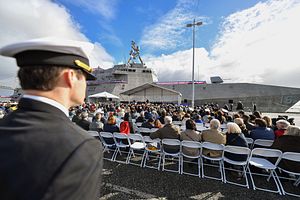The U.S. Navy commissioned the newest Independence-class Littoral Combat Ship (LCS), the USS Tulsa, in a ceremony in San Francisco, California on February 16. The Tulsa is the 15th LCS overall and the eighth of the Independence variant to be commissioned into service. The LCS was christened in February 2017 and delivered to the U.S. Navy in May 2018.
The U.S. Navy’s LCS fleet is divided into the Independence and Freedom variants. Construction of the Freedom class is headed by Lockheed Martin at the Fincantieri Marinette Marine (FMM) shipyard in Marinette, Wisconsin, whereas the construction of Independence-class ships is managed by Austal USA in Alabama. The Austal and Lockheed shipyards are optimized to produce two littoral combat ships per year.
According to Assistant Secretary of the Navy James Guertz, speaking during the commissioning ceremony on February 16, the USS Tulsa is the fifth ship the U.S. Navy has commissioned in the past 50 days and one of 13 ships slated to be commissioned in 2019. Other LCSs currently under construction include the future USS Indianapolis and the future USS St. Louis, next to six other LCSs in various stages of construction. In 2018, five LCSs were handed over to the U.S. Navy, while three are scheduled for delivery in 2019.
The USS Tulsa “will join the fleet at a time of expansion of capability as well as increased demand on the Navy forces,” according to a U.S. Navy press statement. “Having the right mix of ships with the right number of ships, to include Tulsa, makes us ready to execute prompt and sustained combat operations at sea to fight and win against any adversary,” Admiral John C. Aquilino, commander of U.S. Pacific Fleet, was quoted as saying in the statement. “Let there be no doubt, that is what Tulsa is ready to do.”
As I noted previously:
[W]ith 40 percent of the hull reconfigurable, both LCS variants use an open architecture design, enabling the warships to be fitted with interchangeable so-called mission packages providing capabilities for surface warfare (SUW), anti-submarine warfare (ASW), and mine countermeasures (MCM) missions in the littoral zone. The ASW warfare package is expected to become available to the fleet in 2019, while the MCM package will be available in 2020.
Furthermore, I explained:
Each LCS is also expected to be equipped with the Surface-to-Surface Missile Module, a 24-shot AGM-114L Longbow Hellfire missiles vertical launch system, with initial operational capability expected by the end of this year. Additionally, both LCS variants are also armed with a 57-millimeter naval gun and a 11-cell Raytheon RIM-116B SeaRAM missile-defense system.
Notably, according to report by the Pentagon’s office of Operational Test and Evaluation from last January, variants are not suitable for high-intensity combat.
The U.S. Navy accepted delivery of the future USS Billings this month. The service commissioned its seventh Freedom-class LCS, the USS Wichita, at Naval Station Mayport in Florida on January 12.

































